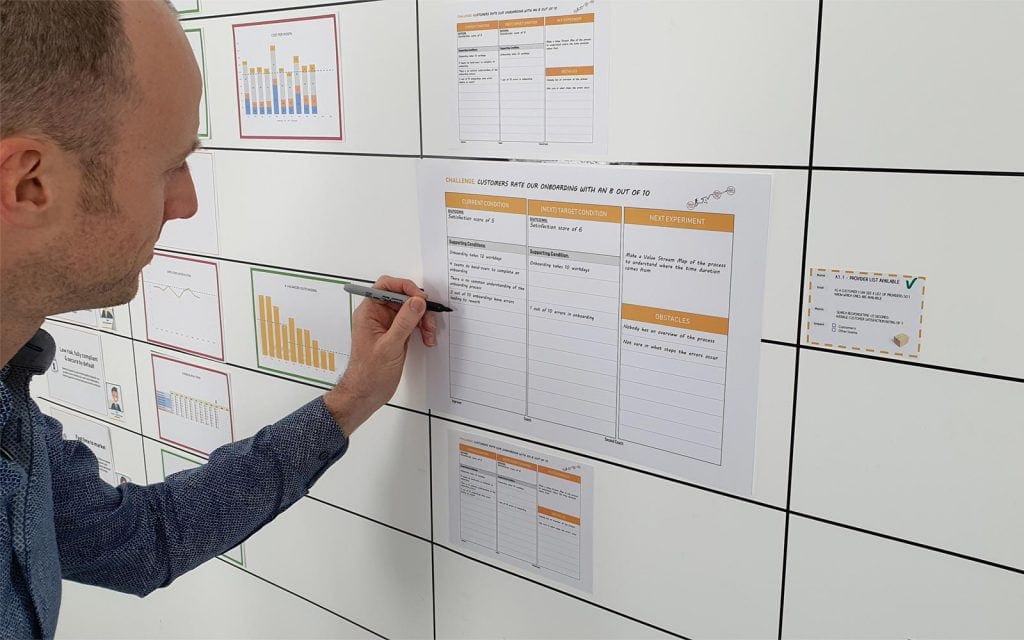
Since I started my new assignment as ‘Obeya Master’ at ING people have been asking me what ‘Obeya’ is. To me, Obeya is the one true (senior) management solution to the question ‘how do we deal with all these teams and their visual management and use that execution power to achieve our organisations strategic goals’.
In spite of the immense increase of interest and implementations in the lean and agile way of working, a lot of organisations today struggle with this issue while others already know the obvious solution.
That’s right, obvious. Because that’s what you’ll think when you walk in to a good Obeya. Imagine walking into a room with your management team and everything you need to know to make decisions and take action to make your organisation more successful is right there on the wall, every time, always. Moreover, it is presented in such a way that you can take your own team in to the room and instantly explain their strategic context and discuss their contributions, impediments and results with them. It all makes complete sense.
Obeya is a Japanese word for ‘room’. Yes, Oobeya is in fact the correct and intended word for ‘large room’, but westerners more commonly (and perhaps mistakenly) write ‘Obeya’. The latter however does the job just fine for this post 🙂
Toyota put Obeya into practice back in 1993 launching their first Prius. All the essential management information for the project gathered in one room. And more importantly all information that didn’t add to value of the product was specifically excluded. Reporting done effectively without waste. Complete focus on value for the customer and a comprehensive shared understanding on the product to be delivered.
Today the call for Obeya usually comes from departments (big and small) that want to govern their business in a visual way. This is not how Obeya originally started, but the principles can be applied all the same to come to an awesome result. One room for all your management needs. I would go as far as a key instrument in implementing your Lean Leadership System effectively.
But it’s not just the visuals that make it happen, it’s the routines the management team should use to work with the visuals that’s at least as important. Without routine, the real power of the Obeya is not extracted; asking the right questions, making the right decisions and taking the right actions at the right time based on the right information.
The type of Obeya that is intended to govern an organisation or organisational unit, commonly has five different areas or walls:
- Strategic
A breakdown of the purpose / true north of the leadership team - Performance
For each aspect of the strategy, a very limited selection of the most powerful actionable metrics for team members, based on the performance of the teams - Plan to value
All delivery activities aligned, showing results and impediments from the teams - Toughn problems
Identifying the most valuable structural improvements / problem solving and monitoring actively how they add to the increased performance of the department - Act & Respond
Action board like a scrum board that supports the catch-ball process with teams as well as prioritisation of topics and alignment in the management team
These aspects together cover a holistic view of the organisation’s purpose. Additionally it also reflects the measure in which it succeeds in meeting that purpose as well as the initiatives it employs to meet or exceed that purpose in the future. Moreover, any prioritised improvements will be visible and display the obvious actions the organisation is taken to further excel their operations and delivery to their customers.
Simple as it may seem there is a long way to go from an empty room to a fully built Obeya and a seasoned management team applying lean and agile principles. But the key is to start with what you’ve got. However if you do, I urge you to get an experienced coach or facilitator to help your team get started. While the benefits of using Obeya can be huge, the access to these benefits requires what is probably a significant change in how your team and the front-line teams operate and work together.
A good coach will guide you in your journey to define the right strategic pillars, metrics, visuals, etc. But he or she will also help get started in the right rhythm and routines for each wall. A very important success factor in implementing Obeya I find is the ‘external’ conscience, which is facilitated by a coach. Even more experienced teams sometimes get sloppy in their routines which immediately risks a demise on the effectiveness of the Obeya.
All in all you can expect the road to a full-fletched Obeya to be bumpy, but it’s absolutely worth it. If you’re not convinced yet, I hope you get the chance to do a reference visit to a team who’s already further down the road and the value of Obeya will be obvious instantly.


